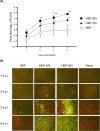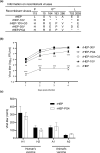Construction of Vero cell-adapted rabies vaccine strain by five amino acid substitutions in HEP-Flury strain
- PMID: 38822013
- PMCID: PMC11143356
- DOI: 10.1038/s41598-024-63337-9
Construction of Vero cell-adapted rabies vaccine strain by five amino acid substitutions in HEP-Flury strain
Abstract
Rabies virus (RABV) causes fatal neurological disease. Pre-exposure prophylaxis (PrEP) and post-exposure prophylaxis (PEP) using inactivated-virus vaccines are the most effective measures to prevent rabies. In Japan, HEP-Flury, the viral strain, used as a human rabies vaccine, has historically been propagated in primary fibroblast cells derived from chicken embryos. In the present study, to reduce the cost and labor of vaccine production, we sought to adapt the original HEP-Flury (HEP) to Vero cells. HEP was repeatedly passaged in Vero cells to generate ten- (HEP-10V) and thirty-passaged (HEP-30V) strains. Both HEP-10V and HEP-30V grew significantly better than HEP in Vero cells, with virulence and antigenicity similar to HEP. Comparison of the complete genomes with HEP revealed three non-synonymous mutations in HEP-10V and four additional non-synonymous mutations in HEP-30V. Comparison among 18 recombinant HEP strains constructed by reverse genetics and vesicular stomatitis viruses pseudotyped with RABV glycoproteins indicated that the substitution P(L115H) in the phosphoprotein and G(S15R) in the glycoprotein improved viral propagation in HEP-10V, while in HEP-30V, G(V164E), G(L183P), and G(A286V) in the glycoprotein enhanced entry into Vero cells. The obtained recombinant RABV strain, rHEP-PG4 strain, with these five substitutions, is a strong candidate for production of human rabies vaccine.
© 2024. The Author(s).
Conflict of interest statement
The authors declare no competing interests.
Figures








Similar articles
-
A recombinant rabies virus carrying GFP between N and P affects viral transcription in vitro.Virus Genes. 2016 Jun;52(3):379-87. doi: 10.1007/s11262-016-1313-2. Epub 2016 Mar 8. Virus Genes. 2016. PMID: 26957093 Free PMC article.
-
A recombinant rabies virus encoding two copies of the glycoprotein gene confers protection in dogs against a virulent challenge.PLoS One. 2014 Feb 3;9(2):e87105. doi: 10.1371/journal.pone.0087105. eCollection 2014. PLoS One. 2014. PMID: 24498294 Free PMC article.
-
Single Amino Acid Substitution in the Matrix Protein of Rabies Virus Is Associated with Neurovirulence in Mice.Viruses. 2024 Apr 28;16(5):699. doi: 10.3390/v16050699. Viruses. 2024. PMID: 38793581 Free PMC article.
-
Research Advances on the Interactions between Rabies Virus Structural Proteins and Host Target Cells: Accrued Knowledge from the Application of Reverse Genetics Systems.Viruses. 2021 Nov 16;13(11):2288. doi: 10.3390/v13112288. Viruses. 2021. PMID: 34835093 Free PMC article. Review.
-
Characterization of P gene-deficient rabies virus: propagation, pathogenicity and antigenicity.Virus Res. 2005 Jul;111(1):61-7. doi: 10.1016/j.virusres.2005.03.011. Epub 2005 Apr 11. Virus Res. 2005. PMID: 15896403 Review.
References
-
- World Health Organization . WHO Expert Consultation on Rabies: Third Report. World Health Organization; 2018.
-
- World Health Organization, Food and Agriculture Organization of the United Nations, & World Organisation for Animal Health. In Zero by 30: The Global Strategic Plan to End Human Deaths from Dog-Mediated Rabies by 2030 (World Health Organization, 2018).
MeSH terms
Substances
Grants and funding
- JP21fk0108141/Japan Agency for Medical Research and Development
- JP21fk0108615/Japan Agency for Medical Research and Development
- JP21fk0108615/Japan Agency for Medical Research and Development
- JP21fk0108615/Japan Agency for Medical Research and Development
- 22HA1005/Ministry of Health, Labour and Welfare
LinkOut - more resources
Full Text Sources
Miscellaneous

